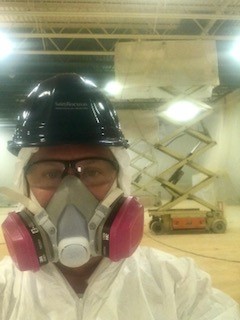5 Things You Need to Know About Asbestos
Even though you may not always see it, asbestos still exists in many old houses and buildings. It is important to be knowledgeable and take proper precautions against this deadly toxin. Read on for five important facts you need to know about asbestos.
1. Many products still legally contain asbestos. These products are mostly used in the construction industry, and may exist in new structures. Asbestos is used to make products resistant to heat. Asbestos is commonly used as an acoustic insulator and a thermal insulator, as well as in fireproofing and building materials. It is also sprayed on structural steel beams, in crawlspaces, and between walls. Today, products such as ceiling tiles, vinyl sheet flooring, roofing shingles, acoustical plaster, electrical wiring insulation, caulking, spackling, adhesives, chalkboards, fire blankets, elevator equipment panels, and thermal paper products all include asbestos.
2. Asbestos becomes hazardous only when it is disturbed and the fibers become airborne. If an asbestos-containing substance is easily crumbled or pulverized with hand pressure, the material is called “friable.” Friable asbestos can become airborne and then enter your lungs when you breathe, leading to disease. Friable substances include the fibrous, fluffy, sprayed-on materials used in insulation, fireproofing, and soundproofing. Non-friable materials, such as floor tile and roofing felt, usually do not emit airborne fibers. The danger to you comes from drilling, cutting, sanding, or disturbing materials that contain asbestos. If you are renovating your home, make sure you have licensed professionals carry out the work according to certain specifications and safety protocols. Do not try to discard asbestos on your own.

SRI safety consultant Scott Powell takes proper procautions by wearing necessary personal protective equipment (PPE) during a recent asbestos awareness class.
3. It could take decades before you notice symptoms related to asbestos exposure. Asbestos is a carcinogen, and may lead to one or more diseases in those who have inhaled its microscopic fibers. Some common asbestos-related diseases are asbestosis and mesothelioma. The longer you are exposed, the greater the risk becomes for you to develop an asbestos-related disease. Asbestosis is a noncancerous, but chronic, and often fatal respiratory disease that occurs after asbestos fibers cause scarring in the lungs. The scarring can cause pain, difficulty breathing, and heart problems. Mesothelioma is a rare form of cancer that is diagnosed in roughly 3,000 Americans each year. It causes a tumor that spreads across the tissue in and around the lungs. Asbestos exposure is accountable for virtually all cases of mesothelioma. These diseases may take up to 40 or 50 years to develop within the body, making many victims of these diseases unaware of their condition.
4. Asbestos fibers remain in the human body once they are inhaled or ingested. Unlike many toxins, asbestos cannot be “flushed out.” Because asbestos fibers are microscopic, the fibers can slip through the lungs’ natural filtration system and penetrate outwardly through the membrane which covers the lungs and lines the chest cavity. The fibers can also be swallowed and penetrate the stomach. Unfortunately, nothing can remove the fibers from the body due to their sharp, needle-like nature. To protect yourself, wear the appropriate respiratory protection and necessary personal protective equipment when in contact with asbestos.
5. Asbestos is still mined and exported in other countries. Despite its health hazards, asbestos is a commodity in countries such as Greece, Canada, Russia, Italy, China, and India. Many of these countries also continue to use and market asbestos widely. Due to asbestos being a low-cost substance, it has become common on construction sites in developing countries.
Source: Asbestos.net
Related Topics: Short Read, Did you know